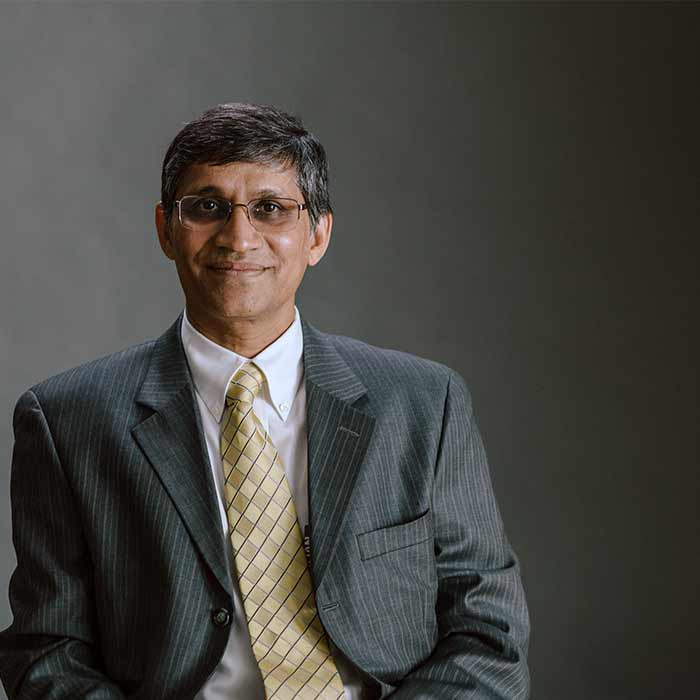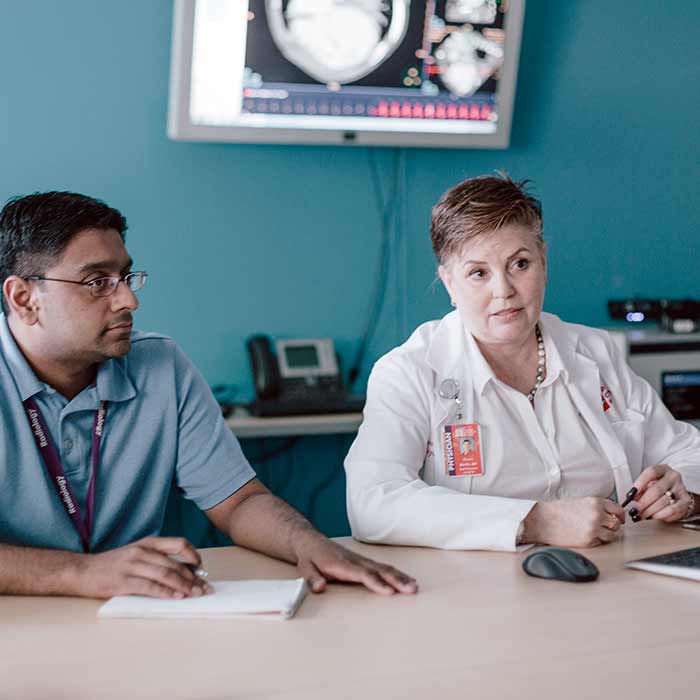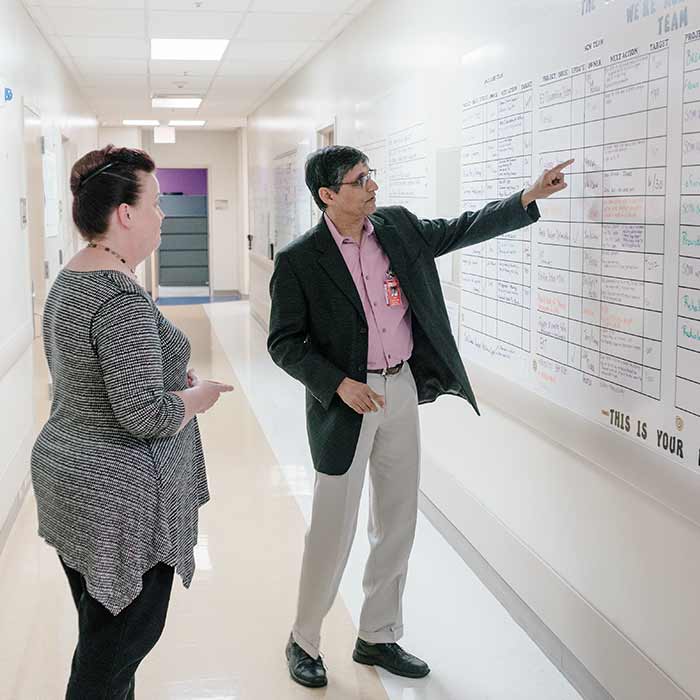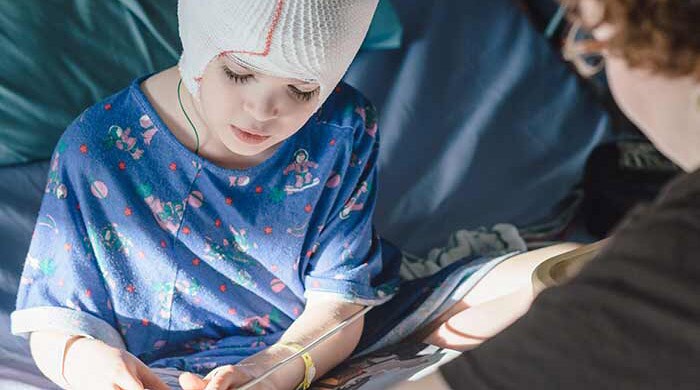No bounds. Better healthcare.
The benefits of integrated health IT
Integrated health IT breaks down barriers for a free flow of health information
At Phoenix Children’s Hospital, information technology links all clinical specialties, connects patients to their doctors, moves images from one location to another and is instrumental in disease control and healthcare planning. It is viewed as an enabler of quality care. IT plays a role when a patient is making an appointment, having an X-ray or interacting with the physician through telehealth. It’s integral to specialists who are looking at infection control across the whole hospital, or when an image is being transmitted across the city or the nation. The common denominator in all these is IT, says Dr. Vinay Vaidya, M.D., Vice President and Chief Medical Informatics Officer at Phoenix Children’s, and good-quality, standardized information that flows efficiently around the hospital is critical to the future of care. “In a hospital like ours, there are many specialists: there is a pulmonary doctor for the lungs, there’s a cardiologist for the heart, an infectious disease specialist. We view clinical IT to be an extension of that service. It’s one more service that helps physicians take care of their patients through information technology,” Dr. Vaidya says.
Free-flowing health information
Clinical care used to involve a very simple series of exchanges – the patient fell ill, paid a visit to the doctor and relayed his or her symptoms. The exchange of information mainly took place using pens and notepads. Today, information technology forms the hub of almost every single clinical activity that relies on the information that is captured. Clinical data, electronic labs, genomics, radiology, imaging and more have evolved rapidly as a result. “The single common point of every aspect that we do in clinical care [IT] is exchanging information,” Dr. Vaidya says. “If you see a patient who is complex, involving many systems, it is amazing to know that almost 90% or 95% of the medically relevant information that is required to take care of the patient resides outside of the patient in electronic form.” The biggest barriers to be broken are the hospital silos, where information can still be residual, locked inside a specialty, unable to flow efficiently and quickly to help the patient. Information technology, with a focus on interoperability, has to play a pivotal role in patient care and it has to be accessed by and available to anybody at anytime from anywhere. Within hospitals, healthcare information can start as islands of innovation, information and technology, held within site-specific locations and unable to be exchanged. “People say data is the new gold or data is the new oil. I would go a bit further than that and say that data is the new life-saving drug,” says Dr. Vaidya. “Really, its smooth flow, its effective flow can do what penicillin did for infections almost 50 years back. It is absolutely crucial that the barriers are broken down, and that universal, uniform, standardized medical information and standardized terminology is free-flowing from one place to other.”
Chronic disease management through health IT
Free-flowing data and the availability of clinical information opens up new possibilities for healthcare providers to move beyond their traditional role in helping people only once they are sick, and instead move towards addressing health concerns among vast populations. Data can be used to better understand the extent of health risk behaviors, adopt more preventive care practices and understand the burden of chronic diseases, as well as identify research gaps, monitor population trends and evaluate programs. “The medicine of disease management is the medicine of data management and information management, to make sure that all the pieces of information are available easily and quickly,” says Dr. Vaidya. Phoenix Children’s sees data and information playing a much bigger role in supporting chronic care management. With more information, patients who have multiple conditions and move between healthcare providers with data dispersed over wide geographies, can be tracked and evaluated, and suitable care pathways can be designed to address their needs. “By its very nature, chronic disease management is where the disease does not go away. You are not cured with one or two visits,” Dr. Vaidya says. “The disease stays with you from one physician to another, from one specialty to another, from one town to another, and yet, all that information that has been accumulated over a period of years has to be collected, has to be easily available.”
Remote patient monitoring through data
Before this information revolution, medical care was centered within the hospital or the physician’s office, with one or two simple measurements – using a scale or a glucose monitor – conducted in the home. Now, a whole range of new technologies can enable remote patient monitoring almost anywhere. Dr. Vaidya says that with around “90% of medical care happening outside of the hospital” the idea that healthcare takes place inside the four walls of a hospital has gone. Now people are realizing that hospitals are not the only focal point of medical care – schools, homes, the workplace, a physician’s office, and other settings are all part of a continuous healthcare experience. Dr. Vaidya adds: “Care is no longer episodic, it’s not discontinued, it’s not disjointed, but rather we should look at it as a continuum of care and it’s just the environment that changes from one place to another. But all these devices are making it possible for the patient to be monitored, no matter where he or she is.”
See how Phoenix Children's Hospital is
Erasing boundaries in pediatric radiology
People say data is the new gold or data is the new oil. I would go a bit further than that and say that data is the new life-saving drug."
Vice President and Chief Medical Children's Hospital
Vinay Vaidya, M.D.
Informatics Officer at Phoenix



Advanced visualization with Philips IntelliSpace Portal
No bounds.
Better healthcare.
There's always a way to make life better.
DISCLAIMER: Results are specific to the institution where they were obtained and may not reflect the results achievable at other institutions.


